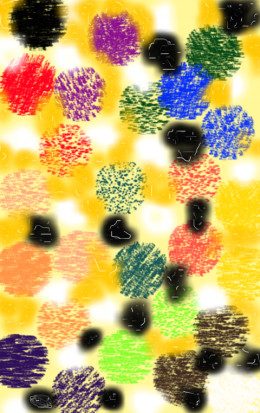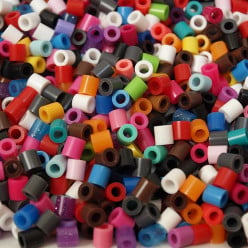How is a pure & absolutely black substance, pigment or object made? Is "true" b
How is a pure & absolutely black substance, pigment or object made? Is "true" black even possible??
Lots of folks say that black is the combination of all the colors. Well, maybe not lots, but I've heard it quipped much more than a few times. But don't almost all colors result from some ratio of the primes: yellow, blue, red, white, and "clear" (nothingness or dilute). Take white and dilute out of the mix, heh heh, for a sec. Any proportions of the 3 primaries produces everything in the "ROYGBIV" spectrum, and every variation and density of BROWN. Throw in white and you get *nearer* to the grey spectrum but not to it. Dilute only leads to opacity. How in the WORLD do you get to black?
absence of light/colour I'd have said. impractical i know but i'm certain it's true
Black is not any mixture of colors, as it is not really a color itself. "Black" is your eyes not picking up any colors; whatever the black item you are looking at is not reflecting any colors from the ROYGBIV spectrum back to your eyes. (Just like how white is a mixture of the entire spectrum being reflected, black is when nothing gets reflected)
The darkest material known to man was recently created at RPI, my school, and you can read about it here: https://www.rpi.edu/dept/metasite/resea … black.html
Regardless. If you want to paint something black, you can get something close enough for artistic purposes when painting by mixing equal portions of the primary colors red, yellow, and blue. (or cyan, magenta, yellow when printing)Black is the lack reflected light, like a black hole. Any artist will tell tell you that if mix lots of colour on your palletts you usually end up with a very unpleasant greeny grey.
But there are so many blacks available, scratch a black car and try and get a match you'll see how many there are. I have two in my paint box, 'lamp black' and midnight black' side by side they are very different.
try not to worry about this, but how did they get black on grey TV screens?True black is not possible, only in coal...
took it in physics last semester.True black would be the total absorption of all light in the visible spectrum, and is not possible in any ordinary physical substance.
In the context of painting and printing, black can be seen in two ways: the absorption of all visible light, or the absence of all visible light.
In terms of absorption, if all light striking the pigment mix is being absorbed, the result is black. There are two ways of doing this. One is with a black pigment, such as charcoal, and the other is with a balanced mix of either cyan, yellow, and magenta (CMY) or red, green, and blue (RGB) pigments. Since a perfect balance is impossible, a perfect black is impossible. The closest we can get is probably in printing, using CMYK, that is, using a strong CMY mix plus a black (K) pigment, as well.
In physics, all energy that is not reflected is absorbed. If an object absorbed all light, it would store all the energy that hit it. That creates physical impossibilities for physical objects.
However, a black hole, an object so massive that it has an event horizon within which even light (traveling at the speed of light) cannot get out is, in a sense, pure black. However, matter falling into the black hole loses energy as it goes in, and that energy radiates outward. So, even though the black hole is pure black (no emission of light at all), it probably appears to glow from surrounding light. But you wouldn't want to get near enough to find out!Wow. Thanks for this answer. I actually thought that a black hole was a pure vaccuum, increasing its pull (gravity) infinitely as it pulls in more and more matter, including (particles??!) of light. If/whn max density occurs, then...**BIG BANG**!!
Your view overall is right. Two notes: The word "vacuum" doesn't fit. A vacuum is empty, a black hole is full of matter. Black holes do pull in photos (particles of light) and not let them out. That's what makes them black. Bang at end: theoretical.
True black is not possible. All "blacks" have some tone of another color and sometimes you can even see it. It can be red, blue, purple.
- ladystarkillerposted 13 years ago
0
I've learned that white was a combination of all the colors. For example, when white light is bent through a prism you get a rainbow. Black, however is the absence of color. Where there is no color there is no light. I'm an art student and this question always puzzled me. Black pigments are always a very dark blue or violet. Even if you look at a blackbird or a crow (or any bird with "black" feathers) that's standing in the sunlight their feathers will give of a different color other than black. So, I suppose, that you cannot TRUELY get black unless there is no light at all. Hope this helps....
Related Discussions
- 5
why is the Sky blue is outer space is dark black ?
by brandonord 14 years ago
why is the Sky blue is outer space is dark black ?
- 3
Why is vegetation green?
by Ytslemp 12 years ago
Why is vegetation green?
- 16
"Love is eternal". Do you think this phrase is true? Can someone be loved till e
by maheshpatwal 14 years ago
"Love is eternal". Do you think this phrase is true? Can someone be loved till eternity?
- 5
What is the difference between black and white?
by Nurfninja 14 years ago
What is the difference between black and white?Can someone explain how colors work? Really, it's very confusing for me.
- 10
When do you think people show their true colours?
by Joanna Chandler 10 years ago
When do you think people show their true colours?For me I think people show their true colours in the time of death....When cornered by the truthWhen someone is prospering or doing better than themWhen your down and sick and really need them, etc.
- 13
Hebrews 11:1 of the New Testament
by Doc Young 11 years ago
Hebrews 11:1, "Now faith ... ". Lot of talk here in Hub world by, for and against the Christian; by for and against the atheist. The above verse is taken from the New Testament (NT). The NT along with the Old Testament (OT) together is the Bible of the orthodox Christian...














